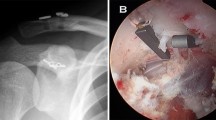Summary
BACKGROUND: The concept of treatment strategies in dislocations of the acromioclavicular joint has changed in recent years. The recommended indication for operative treatment of complete dislocations has been questioned due to the lack of evidence-based results indicating the superiority of such treatment. Although the traumatic acromioclavicular joint separation is a well-known topic, there are different classifications, diagnostic procedures, concepts of intervention and a great variety of implants. Therefore, a comparison of the numerous papers dealing with this topic is difficult. METHODS: An overview of the recent literature is given in this paper. The different therapeutical methods, ranging from nonoperative techniques to different operative procedures such as percutaneous K-wires or other transarticular techniques, extra-articular techniques or secondary procedures like tendon transfers are compared. RESULTS: The current therapeutical algorithms that help to decide on whether operative or nonoperative treatment is the best solution are oriented on the morphological classification, the clinical appearance of the injury and the individual patient's expectations. The wide range of implants available demand a decision based on anatomical and biomechanical considerations. CONCLUSIONS: In this paper an overview of current concepts is given and possible treatment options for acute and chronic cases are discussed. The indication for operative intervention is restricted to the young and physically active patient with a high-grade dislocation of the AC-joint.
Zusammenfassung
GRUNDLAGEN: Das Behandlungsregime nach traumatischen Läsionen des Akromioklavikulargelenkes ist in den letzten Jahren deutlich in Diskussion geraten. Die Indikation zur operativen Therapie bei höhergradigen Dislokationen des Gelenkes kann aufgrund fehlender Studien, die nach den Regeln der Evidence-based Medicine aufgebaut sind, nicht zweifelsfrei dargestellt werden. Unterschiedliche Klassifikationen, differente diagnostische Kriterien und mannigfaltige Therapiekonzepte lassen nur unzureichende Vergleiche verschiedener Studien zu. METHODIK: Die vorliegende Arbeit stellt einen Überblick über die rezente Literatur zu diesem Thema dar. Die verschiedenen therapeutischen Möglichkeiten, von rein konservativer Therapie über perkutane Kirschnerdrahtfixation oder andere transartikuläre Techniken, extraartikuläre Techniken oder sekundäre Rekonstruktionen, werden miteinander verglichen. ERGEBNISSE: Derzeit anerkannte therapeutische Algorithmen orientieren sich an der morphologischen Klassifikation ebenso wie an der individuellen klinischen Erscheinung der Läsion und den Erwartungen des Patienten. Die verschiedenen Implantate, die zur Versorgung zur Verfügung stehen, lassen aufgrund unterschiedlicher biomechanischer Eigenschaften keine einheitliche Empfehlung zu. SCHLUSSFOLGERUNGEN: Die vorliegende Literaturübersicht soll daher helfen, die möglichen Behandlungskonzepte für akute und chronische Läsionen in komprimierter Form darzustellen und zu diskutieren. Die Indikation zu einer operativen Intervention sollte auf den jungen, sportlich aktiven Patienten beschränkt sein und nur bei höhergradiger Instabilität des Gelenkes erfolgen.
Similar content being viewed by others
Author information
Authors and Affiliations
Corresponding author
Rights and permissions
About this article
Cite this article
Fialka, C., Stampfl, P., Oberleitner, G. et al. Traumatic acromioclavicular joint separation – Current concepts. Eur Surg 36, 20–24 (2004). https://doi.org/10.1007/s10353-004-0035-1
Published:
Issue Date:
DOI: https://doi.org/10.1007/s10353-004-0035-1




